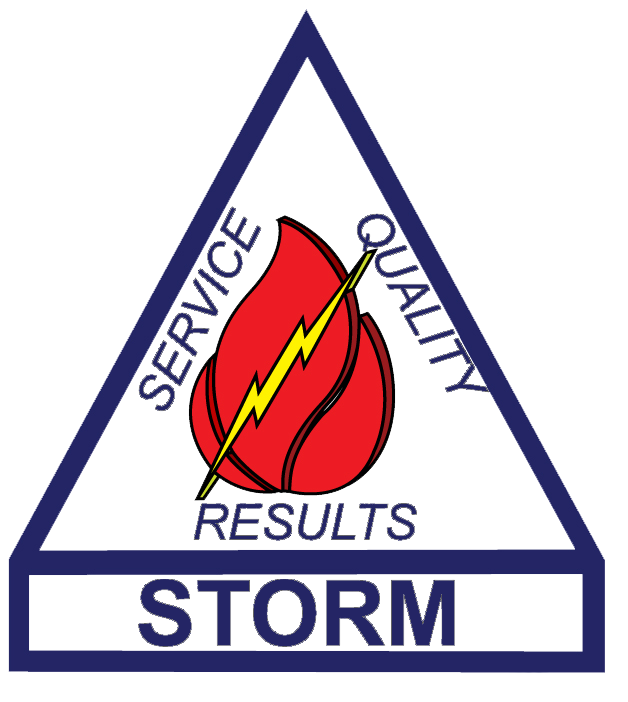STORM's 13 Essentials
These STORM 13 Essentials have expanded from the 10 prerequisites for optimum combustion, first promoted in the 1980’s. The point is, they are simple, have been around a long time, and they make a great “punch list” for resolving slagging, L.O.I., and NOx issues in large P.C.-fired utility boilers.
Furnace Essentials
Furnace Essentials
- Furnace exit must be oxidizing (preferably at 3%)
- Overfire air shall be accurately measured & controlled to ±3% accuracy
Supporting Newsletters
- May 2023 - HVT Testing is Still Important!
- April 2023 - Testing Efficiency Improvement with SOAR System
- March 2023 - “Shock Wave” Impulse Cleaning Device Case Study
- Sept. 2020 - Ignoring the Fundamentals of Combustion
- Apr. 2020 - "STORM Approach to Reliability"
- Aug. 2016 - "Would You Like to Better Utilize Your Outage Resources"
- July 2015 - "Large Utility Boiler Design Considerations for Cycling and Low Load Operation"
Burner Essentials
Burner Essentials
- Mechanical tolerances of burners and dampers shall be ±1/4" or better
Supporting Newsletters
- Jan. 2023 - Periodic Monitoring can Prevent Forced Outages During Peak Demand
- Sept. 2020 - Ignoring the Fundamentals of Combustion
- Aug. 2020 - The Importance of Fuel Fineness - Part 2
- June 2020 - Airflow Management on Corner Fired Boilers - Part 1
- Apr. 2020 - "STORM Approach to Reliability"
- Aug. 2016 - "Would You Like to Better Utilize Your Outage Resources"
Airflow Essentials
Airflow Essentials
- Primary airflow shall be accurately measured & controlled to ±3% accuracy
- Primary air/fuel ratio shall be accurately controlled when above minimum airflow set-point
- Secondary airflow indication should be within ±3% of the measured airflow and distribution to the burners within ±5%
Supporting Newsletters
- Feb. 2023 - Storm's Fabrication Capabilities And Outage Support
- June 2020 - "Airflow Management on Corner Fired Boiler"
- Mar. 2015 - "Cycling of Large Utility Boilers, Some Thoughts to Consider"
- Oct. 2012 - "Measurement of Combustion Airflow"
- Sep. 2011 - "Airflow Measurement: The Growing Importance of Accurate and Reliable Combustion"
- May 2010 - "The Benefits of Flow Nozzles and Venturis"
Pulverizer Essentials
Pulverizer Essentials
- Fuel lines balanced to each burner by "clean air" test to ±2% or better
- Fuel lines balanced by "dirty air" test to ±5% or better
- Fuel lines balanced in fuel flow to ±10% or better
- Fuel line fineness shall be 75% or more passing a 200 mesh screen and 50 mesh particles shall be less than 0.1%
- Fuel line minimum velocities shall be above 3,300 fpm
- Fuel feed to the pulverizers should be smooth during load changes, measured and controlled as accurately as possible. Load cell equipped gravimetric feeders are preferred
- Fuel feed quality and sizing should be consistent. Raw coal "top size" should not exceed 3/4" to each pulverizer
Supporting Newsletters
- Feb. 2023 - Storm's Fabrication Capabilities And Outage Support
- May 2022 - Pulverizer Puffs - Part 2
- April. 2022 - Pulverizer Puffs - Part 1
- Aug. 2020 - The Importance of Fuel Fineness - Part 2
- Aug. 2016 - "Would you like to better utilize your outage resources
- Oct. 2015 - "Diagnosing Pulverizer Problems"
- Aug. 2014 - "The Storm Approach to Achieving Optimization Pulverizer Performance"
STORM 13 Essentials
for Optimum Combustion for Low NOx Burners on P.C. Boilers
- Furnace exit must be oxidizing (preferably at 3%)
- Fuel lines balanced to each burner by “clean air” test to ±2% or better
- Fuel lines balanced by “dirty air” test to ±5% or better
- Fuel lines balanced in fuel flow to ±10% or better
- Fuel line fineness shall be 75% or more passing a 200 mesh screen and 50 mesh particles shall be less than 0.1%
- Primary airflow shall be accurately measured & controlled to ±3% accuracy
- Overfire air shall be accurately measured & controlled to ±3% accuracy
- Primary air/fuel ratio shall be accurately controlled when above minimum airflow set-point
- Fuel line minimum velocities shall be above 3,300 fpm
- Mechanical tolerances of burners and dampers shall be ±1/4″ or better
- Secondary airflow indication should be within ±3% of the measured airflow and distribution to the burners within ±5%
- Fuel feed to the pulverizers should be smooth during load changes, measured, and controlled as accurately as possible. Load cell equipped gravimetric feeders are preferred
- Fuel feed quality and sizing should be consistent. Raw coal “top size” should not exceed 3/4″ to each pulverizer
STORM 13 Essentials
for Optimum Combustion for Low NOx Burners on P.C. Boilers
- Furnace exit must be oxidizing (preferably at 3%)
- Fuel lines balanced to each burner by “clean air” test to ±2% or better
- Fuel lines balanced by “dirty air” test to ±5% or better
- Fuel lines balanced in fuel flow to ±10% or better
- Fuel line fineness shall be 75% or more passing a 200 mesh screen and 50 mesh particles shall be less than 0.1%
- Primary airflow shall be accurately measured & controlled to ±3% accuracy
- Overfire air shall be accurately measured & controlled to ±3% accuracy
- Primary air/fuel ratio shall be accurately controlled when above minimum airflow set-point
- Fuel line minimum velocities shall be above 3,300 fpm
- Mechanical tolerances of burners and dampers shall be ±1/4″ or better
- Secondary airflow indication should be within ±3% of the measured airflow and distribution to the burners within ±5%
- Fuel feed to the pulverizers should be smooth during load changes, measured and controlled as accurately as possible. Load cell equipped gravimetric feeders are preferred
- Fuel feed quality and sizing should be consistent. Raw coal “top size” should not exceed 3/4″ to each pulverizer
